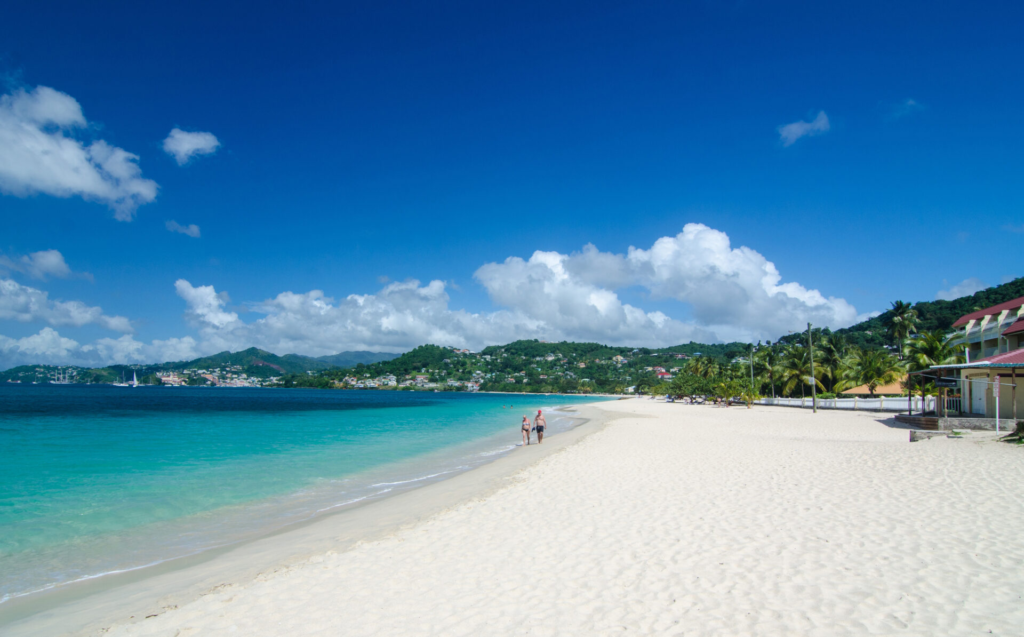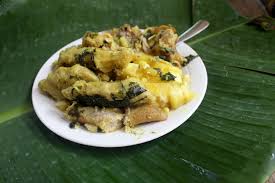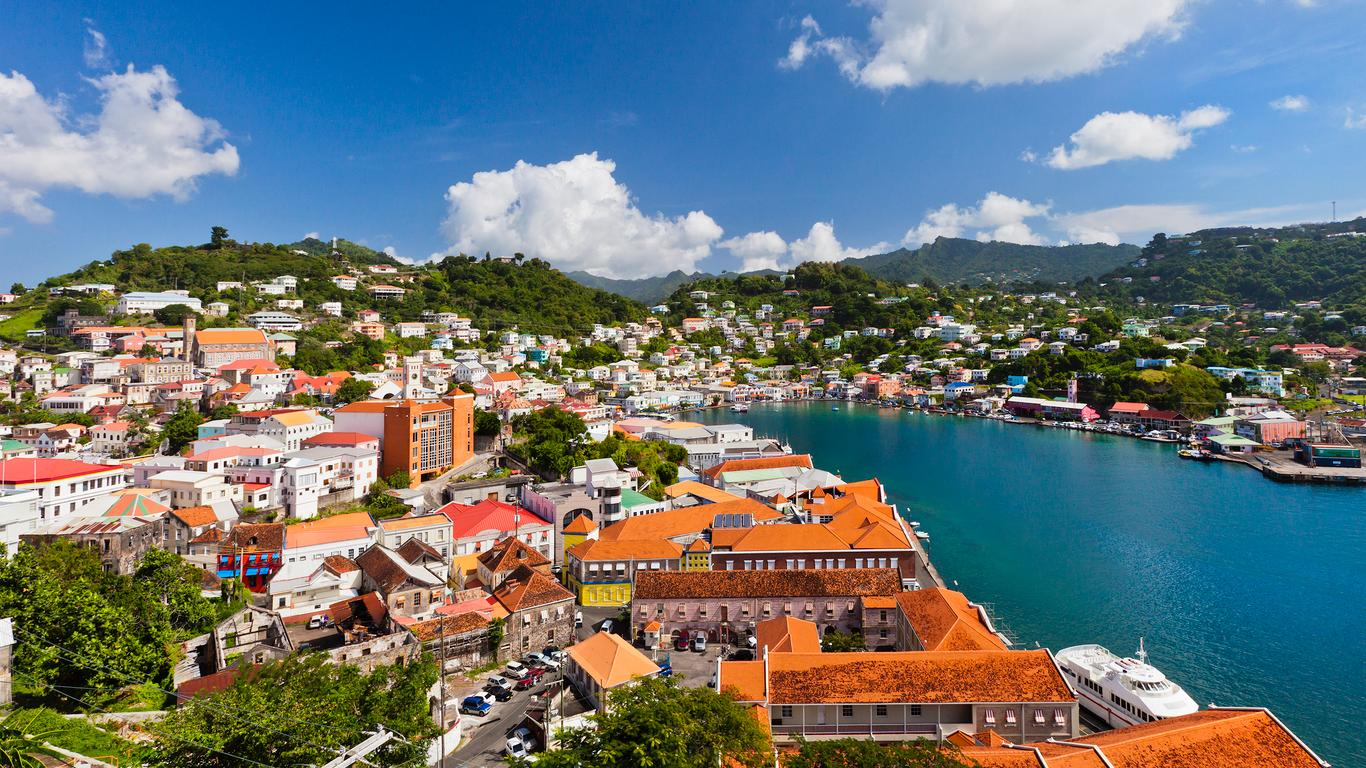Grenada, affectionately known as the “Spice Isle” for its rich production of spices like nutmeg, cloves, and cinnamon, is a captivating destination in the Caribbean. This beautiful island nation offers a delightful blend of natural beauty, vibrant culture, and historical charm. With its stunning landscapes, rich heritage, and warm hospitality, Grenada provides an unforgettable experience for travelers seeking both adventure and relaxation.
Table of Contents
Geography
Grenada is located in the southeastern Caribbean Sea, approximately 160 kilometers north of Venezuela and 40 kilometers south of Saint Vincent and the Grenadines. The island nation is composed of the main island of Grenada and several smaller islands, including Carriacou and Petite Martinique. Covering an area of about 344 square kilometers, Grenada is one of the smaller islands in the Caribbean, yet it boasts a diverse and captivating landscape.
The island’s terrain is characterized by its mountainous topography, with the Grand Etang National Park featuring lush rainforests, volcanic craters, and scenic waterfalls. The coastline is dotted with beautiful beaches and natural harbors, providing ample opportunities for outdoor activities and relaxation. Grenada’s geography includes rolling hills, tropical forests, and pristine beaches, making it an ideal destination for nature enthusiasts and adventure seekers alike.
States of Grenada
Grenada is not divided into states. Instead, it is a single, sovereign island nation composed of the main island of Grenada and several smaller islands, including Carriacou and Petite Martinique. The country is divided into six parishes, which are the administrative regions. Here is a table listing the parishes of Grenada along with their capitals:
| No. | Parish | Capital |
|---|---|---|
| 1 | Saint George | St. George’s |
| 2 | Saint John | Gouyave |
| 3 | Saint Mark | Victoria |
| 4 | Saint Patrick | Sauteurs |
| 5 | Saint Andrew | Grenville |
| 6 | Saint David | St. David’s |
History
Grenada’s history is rich and varied, shaped by its indigenous peoples, European colonization, and post-colonial developments. The island was originally inhabited by the Arawak and Carib tribes, who lived off the land and sea. In the 15th century, Spanish explorers were among the first Europeans to encounter Grenada, but it was the French who established the first permanent settlement in the 17th century.
Throughout the 18th century, Grenada changed hands multiple times between the French and British. The island was officially ceded to Britain in 1763 under the Treaty of Paris. During this colonial period, Grenada developed its plantation economy, with sugar and spices becoming major export commodities. The island gained independence from Britain on February 7, 1974, and has since evolved into a stable democratic nation. Despite facing political challenges, including a 1983 U.S. intervention, Grenada has emerged as a peaceful and thriving destination.
Top Ten Must-Visit Destinations
1. Grand Anse Beach

Grand Anse Beach is one of Grenada’s most famous and picturesque beaches, stretching for about 3 kilometers along the island’s southwestern coast. Renowned for its powdery white sand and crystal-clear waters, the beach is a haven for sunbathers, swimmers, and water sports enthusiasts. The gentle waves and calm waters make it an ideal spot for families and relaxation. Lined with restaurants, bars, and shops, Grand Anse Beach provides a vibrant atmosphere and convenient amenities for visitors.
2. St. George’s

St. George’s, the capital city of Grenada, is a charming port city located on the island’s western coast. The city is known for its colorful colonial architecture, bustling markets, and scenic harbor. Notable landmarks include Fort George, which offers panoramic views of the city and harbor, and The Carenage, a picturesque waterfront area lined with cafes and shops. Visitors can explore local markets, enjoy fresh seafood, and immerse themselves in the city’s rich cultural heritage.
3. Grand Etang National Park

Grand Etang National Park is a lush and diverse protected area situated in Grenada’s central highlands. The park features a volcanic crater lake, dense rainforests, and a variety of wildlife, including tropical birds and monkeys. Visitors can hike the trails to explore the park’s natural beauty, including the scenic Seven Sisters Waterfalls. The park offers opportunities for eco-tourism, including hiking, birdwatching, and nature photography.
4. Annandale Falls

Annandale Falls is a beautiful waterfall located near St. George’s, cascading over a rocky cliff into a natural pool below. Surrounded by lush tropical vegetation, the falls create a serene and picturesque setting. Visitors can take a short hike to reach the falls and enjoy a refreshing swim in the pool. The site is also home to a small local market where visitors can purchase handcrafted souvenirs and local snacks.
5. Carriacou

Carriacou is a charming island situated to the northeast of Grenada, known for its unspoiled beauty and relaxed atmosphere. The island features stunning beaches, clear waters, and traditional Caribbean villages. Visitors can explore Hillsborough, the island’s main town, and experience its local culture and cuisine. Carriacou is also an excellent destination for snorkeling and diving, with vibrant coral reefs and diverse marine life.
6. Petite Martinique

Petite Martinique is a small island located northeast of Carriacou, known for its tranquil beaches and traditional fishing villages. The island offers a peaceful retreat with opportunities for snorkeling, swimming, and exploring its natural beauty. Petite Martinique is less developed than Grenada and Carriacou, providing an authentic Caribbean experience focused on local culture and traditions.
7. Spice Plantations

Spice Plantations in Grenada provide a fascinating insight into the island’s history and economy. Visitors can tour working spice farms, such as The Gouyave Nutmeg Processing Station, to learn about the cultivation and processing of nutmeg, cloves, and cinnamon. These tours offer a glimpse into traditional methods of spice production and highlight the significance of the spice industry to Grenada’s cultural and economic landscape.
8. Fort Frederick

Fort Frederick is a historic fortification situated on a hill overlooking St. George’s. The fort offers panoramic views of the city, harbor, and surrounding coastline. Built by the French in the 18th century, Fort Frederick played a significant role in Grenada’s colonial history. Visitors can explore the well-preserved walls and ramparts of the fort, and learn about its historical significance through informative exhibits and guided tours.
9. River Antoine Rum Distillery

River Antoine Rum Distillery is one of the oldest rum distilleries in the Caribbean, located in northern Grenada. The distillery uses traditional methods to produce high-quality rum, including a waterwheel-driven grinding mill and copper pot stills. Visitors can tour the distillery to witness the production process, sample various rum varieties, and learn about the island’s rum-making heritage.
10. Mt. Qua Qua

Mt. Qua Qua is a scenic hiking destination in Grand Etang National Park. The trail to the summit offers breathtaking views of the surrounding rainforests, mountains, and coastline. The hike is moderately challenging, with diverse flora and fauna along the way. Reaching the summit provides a rewarding panoramic view of Grenada’s natural beauty, making it a popular spot for hikers and nature enthusiasts.
Culture
Grenada’s culture is a vibrant tapestry woven from African, Caribbean, and European influences, reflected in its music, art, and traditions. The island’s cultural heritage is celebrated through various festivals and events, including the annual Grenada Carnival, which features colorful parades, lively music, and elaborate costumes. The carnival is a highlight of Grenada’s cultural calendar, showcasing the island’s creativity and community spirit.
Grenadian cuisine is a reflection of the island’s diverse cultural influences, featuring a mix of Caribbean flavors and international influences. Traditional dishes include Oil Down, a hearty stew made with salted meat, dumplings, and vegetables, and Grenadian Pepper Pot, a spicy dish made with pork and local spices. Grenada’s culinary scene is complemented by a range of dining options, from local eateries to upscale restaurants.
Festivals
Grenada Carnival is one of the most celebrated festivals on the island, taking place annually in August. The carnival features vibrant parades, live music, and elaborate costumes, reflecting the island’s rich cultural heritage and creative spirit. The festival is a time of celebration and unity, with locals and visitors coming together to enjoy the festivities and showcase their talents.
Spice Mas is another popular festival held in Grenada, celebrating the island’s rich spice heritage. The festival features spice-themed events, including cooking demonstrations, spice markets, and cultural performances. It highlights the importance of spices in Grenadian culture and economy, offering visitors a unique opportunity to experience the island’s culinary traditions.
Economy
Grenada’s economy is primarily driven by tourism, agriculture, and services. The tourism sector is a major contributor to the island’s economy, attracting visitors with its beautiful beaches, luxury resorts, and cultural attractions. The government has invested in developing infrastructure and amenities to support the tourism industry, including upgrading airports and expanding hotel accommodations.
Agriculture also plays a significant role in Grenada’s economy, with the island being a major producer of spices such as nutmeg, cloves, and cinnamon. The spice industry is an important part of Grenada’s cultural heritage and export economy. In recent years, there has been a focus on diversifying agricultural production and exploring new markets for local products.
Cuisine
Grenadian cuisine is a flavorful blend of Caribbean and international influences, showcasing a variety of ingredients and cooking techniques. Oil Down is a traditional dish made with salted meat, dumplings, and vegetables, cooked in coconut milk and seasoned with local spices. This hearty and flavorful stew is a staple of Grenadian cuisine and reflects the island’s culinary heritage.
Grenadian Pepper Pot is another popular dish, made with pork and seasoned with a blend of spices, including cloves and allspice. The dish is often served with bread or rice and highlights the island’s rich spice traditions. Grenada’s cuisine also features a range of seafood dishes, such as Grilled Fish and Crabback, showcasing the island’s access to fresh, local ingredients.
Top Eight Most Famous Food








Ten Interesting Facts About Grenada
- Grenada is known as the “Spice Isle” due to its production of nutmeg, cloves, and cinnamon.
- The island gained independence from Britain on February 7, 1974.
- Grenada is home to the world’s first underwater sculpture park, created by artist Jason deCaires Taylor.
- The island has more than 45 beaches, offering a wide variety of options for relaxation and water activities.
- Grenada’s highest peak is Mount Saint Catherine, which stands at 840 meters above sea level.
- The island’s official language is English, but Grenadians also speak a local dialect known as Grenadian Creole.
- Grenada’s capital city, St. George’s, is known for its historic architecture and scenic harbor.
- The island’s national dish, Oil Down, is a hearty stew made with salted meat, dumplings, and vegetables.
- Grenada’s Carnival, known as Spice Mas, is celebrated annually in August and features vibrant parades and music.
- The island is home to the Grand Etang National Park, a protected area with a volcanic crater lake and diverse wildlife.
Conclusion
Grenada, with its stunning natural landscapes, rich cultural heritage, and warm hospitality, is a Caribbean paradise waiting to be explored. From the pristine beaches of Grand Anse to the lush rainforests of Grand Etang, the island offers a diverse range of experiences for travelers. Its vibrant festivals, flavorful cuisine, and historical landmarks provide a unique and immersive travel experience. Whether you’re seeking adventure, relaxation, or cultural enrichment, Grenada promises a memorable and enchanting escape.

